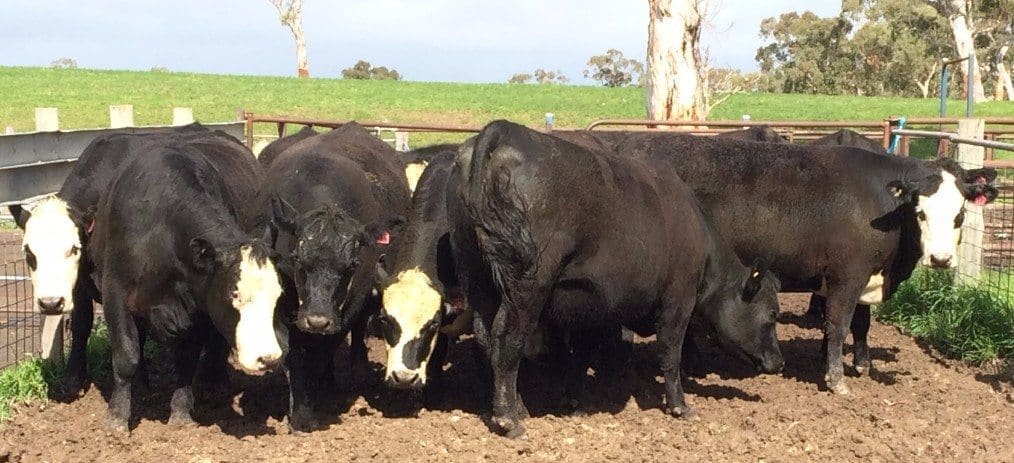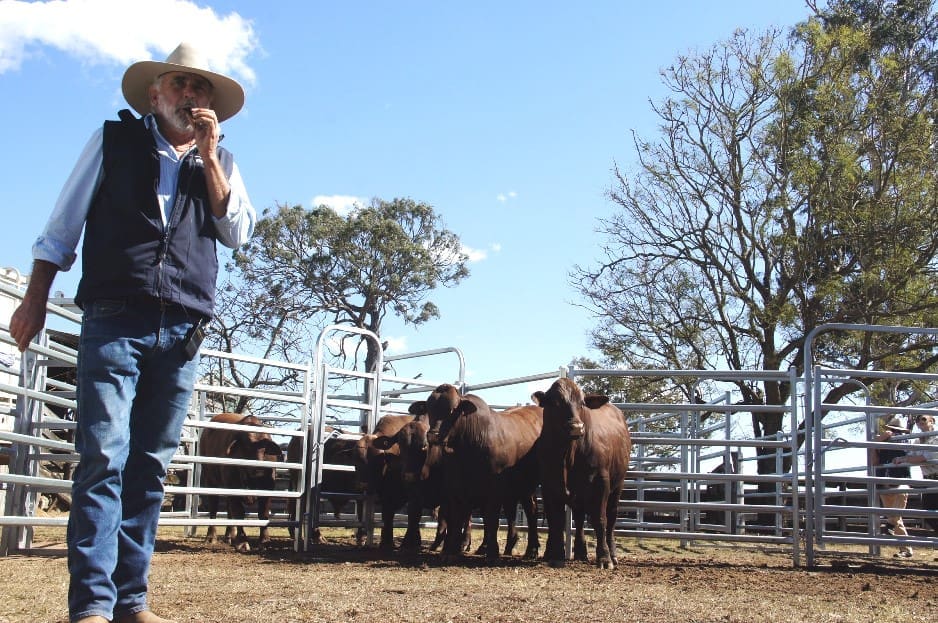
CROSSBREEDING has long been recognised as an opportunity for producers to increase the productivity of their cattle enterprises.
The effect of hybrid vigor across the key areas of growth, fertility and adaption have been central to the crossbreeding story. While crossbreeding offers these advantages, the number of operations using crossbreeding in the commercial Australian beef industry seems to be on a decline across many areas.
Bill Hoffman from Hoffman Beef Consulting on the NSW North coast is a long-time advocate of crossbreeding systems. Involved in early crossbreeding trials on the NSW North Coast at Grafton, he maintains the advantages of crossbreeding cannot be overlooked.
“The science hasn’t changed” he said. “I was recently talking at a Brahman field day on the North Coast, and I pointed out that the key profit drivers for any system are growth rate, fertility rate and weaning rate. And the easiest and most effective way to control those three things is with a well-designed crossbreeding program.”
While the science remains sound, the level of commitment appears to be declining in many areas. Bill Hoffman considers there are a number of reasons for this. These include the fact many producers are “being swamped with other messages, particularly around sale price.”

Beef consultant, Bill Hoffman, speaking at a Yulgilbar Santa field day
The dollar return from straightbreds versus crossbreds
Price remains a dominant consideration for many producers, who closely compare the average price per kilogram offered for straightbred cattle, particularly black cattle feeder and slaughter premiums against crossbred cattle.
While the price per kilogram may be significant, how well does that contribute to overall profitability? A recent analysis I conducted for northwest graziers highlighted the actual price difference per head between Angus steers and black baldy steers of the same age sold at Tamworth.
The straightbred black cattle received on average 7c/kg liveweight more than their same aged brothers. However the baldy steers were on average 25kg heavier.
The net difference on a per-head basis was $44 or a 3pc increase in value on the black baldies – despite the c/kg price difference.
Alternatively, to be on par with those crossbred steers, the straightbred premium offered would need to be on average 17c/kg higher.
While saleyard or grid prices for slaughter or feeder animals focus most attention, profit in a herd is driven in other ways. Growth rate, fertility and cow longevity all influence the revenue figures of any breeding herd. It is important these factors are not overlooked when comparing the ‘value’ of any breeding system.
As part of the recent enterprise evaluation I undertook, I also evaluated the impact of crossbreeding over the herds that were straight-breeding, and those that were focused on cross breeding.
The evaluation highlighted a 7pc increase in gross margin for the crossbreeding herds. The difference was largely due to increased sales resulting from improved fertility with more calves being born and raised to weaning.
Greater longevity was also seen, with F1 cows tending to stay in the herd on average one year longer, resulting in lower replacement rates and a resulting higher number of surplus females for sale.
In line with Bill Hoffman’s observations that crossbreeding isn’t new or novel, these results largely reflect other programs I and many other advisors and producers have seen over time.
What’s behind the decline in popularity in crossbreds?
Given the strong proof of the value of crossbreeding, it’s hard to understand why crossbreeding systems are declining in popularity.
Several reasons have been suggested. While the price differential that appears to favour straight black cattle is one key suggestion, there are other reasons.
Bill Hoffman cites the change in demographic, with many smaller producers considering crossbreeding systems too difficult to mange.
“They see managing mating groups and bulls as being more difficult. It’s harder for some people to consider buying bulls from different breeds and then managing the variation in phenotypes, particularly at marketing,” he said.
Another significant change has been the improvement within breeds. It’s possible now for producers to find genetics and phenotypes within breeds that suit their operations, and so the need to go outside a breed to find complementarity in order to meet market requirements and environmental considerations.
While these are valid reasons, it’s important not to sacrifice the opportunities associated with crossbreeding in the search for simplicity.
It is a challenge to look beyond the grid price offered or the saleyard reports and calculate the overall advantage increased weight and fertility offers a businesses income. However for those producers prepared to dig a little deeper and consider their overall production goals, the advantages are generally very rewarding.
- What do readers think? Is crossbreeding currently in decline, as genetics central editor Alastair Rayner suggests? If so, what are the reasons? Add your comment using the reader comment panel below.

Alastair Rayner
Alastair Rayner is the Principal of RaynerAg, an agricultural advisory service based in NSW. He regularly attends bull sales to support client purchases and undertakes pre sale selections and classifications. He can be contacted here or through his website www.raynerag.com.au

Have been straight and cross breeding for over 50 years with great results for the triple bottom line.
I have a saying: “the better your fullbloods, the better your cross breds are”.
The best advantage is in one’s F1 cows.
The Angus breed is a great breed that have concentrated on performance rather than how they look (eg show ring), and their marketing has also been excellent.
The Angus rise to fame and their emphasis on fullbloods, has made it difficult for most the minor breeds.
As an industry, I believe we need to preserve and enhance the breed diversity of the Oz beef herd to allow future generations of breeders to have choice in their breeding programs.
Very well presented article. For me the three main profit drivers are fertility, calving ease and feed conversion. I changed from Herefords to Angus to Salers. I now cross my Salers cows to Charolais and Limousin both red and black. Some of my straight bred steers have gained 3.5 kilos per day in the feedlot. Salers heifers are joined at 9 months due to large pelvic size. I just wish we could get a good run of seasons to get them all prime at 9 months. Vital to get them off at 9 months at 290kg for Feedlot weight. A weaned calf can take 3/4 months to reach weaning weight dead money and feed the cows should get.
I started cross-breeding after my father died in late 2006. He had a straight horned hereford herd that I quickly learnt (apart from being old, run-down and in-bred) needed to be cross-bred (amongst other things). (I am converting to poll herefords). I have always loved Santa-Hereford Cross BUT had heard of Santa bulls being lazy necessitating 2 bulls per mob but was ultimately drawn by the angus cross that offered less calving issues and a black-premium. I chose right.
(I still love Santa-cross Herefords).
I am getting older and it’s hard to keep up with improved angus bulls and remain viable (given awful store weaner prices of late). I decided I am too exposed to the weaner market a month or more ago and have decided I will continue with a less cow breeding herd (due to break up of family farms) and keep some of my best store-weaner steers to grow on to 2 year olds. Funnily enough, at least two more experienced producers had come to the same opinion and they too are encouraging NR breeders to keep more of their store weaner steers and have less exposure to the very fragile store weaner steer market.
JK
Perhaps another reason is MLA’s inability to take MSA all the way through to the supermarket/butchers shelf. The only thing that should matter is the MSA Index and hide color should be unimportant. But Angus has become a default option because the consumer, in the absence of objective eating quality information, will always opt for Angus just to be on the safe side. We know from extensive research that other breeds e.g. Murray Grey, Red Poll, Devon will marble and eat just as well as Angus. Twenty years ago research at the Meat Animal Research Center at Clay Centre, Nebraska concluded that Red Poll had higher marbling and lower shear force (i.e. more tender) than Angus. I am surprised that the other breed societies have given MLA a free pass on this one. Passing up the extra kilos and yield (which MSA also doesn’t measure) is not smart for an industry competing with poultry and swine, both of which have used cross breeding to great effect.
In defence of the MLA/MSA references in your comment, Sue, MSA was never intended to be a customer-facing retail brand. Some butchers may have used it that way in earlier times, but that was not its intended purpose. It was designed as a quality program to underpin commercial beef brands, which it continues to do with great effect. Editor
Feed, water and fertility are the top three IMO – genetics comes some way after that. But, being farmers, we like straight fences and straight runs of cattle because it appeals to the senses, to hell with results!
Yes there is a decline in cross breeding particularly below the blue tongue line. Perhaps Bill would like to include in his calculations the prices being offered for purebred category 2 heifers for the live export markets, regularly $400-$600/hd more than their cross bred or composite sisters.
Right or wrong that is the main driver for declining cross breeding in Southern Australia.
There is far more to effective and efficient crossbreeding than just the pursuit of heterosis.
The lamb industry has reaped the rewards over the years with cross breeding through heavier carcass weights and meat quality generating more profit for them.
But for some reason a lot of cattle produces can’t seem to grasp the concept of the increase in profitability in using crossbreeding.
It is the cheapest way to increase your return on your cattle enterprise.
Nice job Al….. as you mention the real advantage of crossbreeding is for survival/fitness type traits. We need crossbred cows for greater reproduction and longevity ….. and it wouldn’t hurt to have crossbred bulls to increase their productive life as well! The main issue with effective crossbreeding is that it often goes astray after the initial cross, especially when the wrong crossbred genetics end up in the cow herd. However Tom has a simple solution to do rotational or composite breeding programs to retain a (high) percentage of the hybrid vigour, but again it needs a plan the make sure the right breeds are put into the mix and the program is big enough to avoid inbreeding.
Dave Johnston is principal scientist with the Animal Genetics and Breeding Unit in Armidale. Editor
We need a crossbred grass fed brand
Yes Alastair is correct……..crossbreeding systems are in decline. The main reason is the constant barrage of purebred propaganda pushed by not only the breeders of specific breeds but also by the supposed experts.
Perhaps the lack of performance figures on many potential breeds, that could be involved in a cross-breeding enterprise, makes it difficult for progressive breeders to find the right animals amongst alternate breeds to introduce into a program.
Your figures confirm the old agents mantra viz ” weight will beat rate” . When I lot feed our Angus and 50/50 Angus x Brahman steers the x-breeds net the most because they are heavier, to spite a 10-15c Angus Premium. Their sisters are handling our record drought a whole lot better as well.
Use homozygous black composites easier than rotational cross breeding. As easy to to implement as a purebred system and same $ per kg as angus.